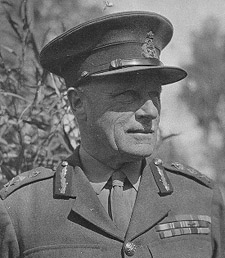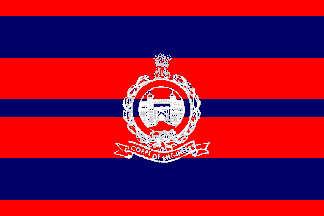|
10th Indian Motor Brigade
The 10th Indian Motor Brigade was a formation of the Indian Army during World War II. It was formed in Egypt in March 1942. The brigade left Egypt for Persia in September 1942 and was converted to the 60th Indian Infantry Brigade in July 1943. During its time active the brigade was under the command of three different higher formations, the 10th Armoured Division, the 51st Highland Division, and, from September 1942 to 1943, the Tenth Army. Formation * 1st Duke of York's Own Skinner's Horse * Central India Horse (21st King George V's Own Horse) *5th Battalion, 13th Frontier Force Rifles * 10th Queen Victoria's Own Frontier Force Guides Cavalry ay - June 1942*402nd Field Squadron Indian Engineers and from November 1942 *3rd Battalion, 11th Sikh Regiment *4th Battalion, 8th Punjab Regiment The 8th Punjab Regiment was a regiment of the British Indian Army from 1922 to 1947. It was transferred to Pakistan Army on Partition of India in 1947 and merged with the Baluch Regimen ... [...More Info...] [...Related Items...] OR: [Wikipedia] [Google] [Baidu] |
British India
The provinces of India, earlier presidencies of British India and still earlier, presidency towns, were the administrative divisions of British governance on the Indian subcontinent. Collectively, they have been called British India. In one form or another, they existed between 1612 and 1947, conventionally divided into three historical periods: *Between 1612 and 1757 the East India Company set up Factory (trading post), factories (trading posts) in several locations, mostly in coastal India, with the consent of the Mughal emperors, Maratha Empire or local rulers. Its rivals were the merchant trading companies of Portugal, Denmark, the Netherlands, and France. By the mid-18th century, three ''presidency towns'': Madras, Bombay and Calcutta, had grown in size. *During the period of Company rule in India (1757–1858), the company gradually acquired sovereignty over large parts of India, now called "presidencies". However, it also increasingly came under British government over ... [...More Info...] [...Related Items...] OR: [Wikipedia] [Google] [Baidu] |
Tenth Army (United Kingdom)
The Tenth Army was a field army of the British Army during the Second World War created in Iraq and formed from the major part of "Paiforce" (Persia and Iraq Force). It was active in 1942 and 1943, and then disbanded. In April 1941, British and Indian troops had been deployed to Iraq from India under the command of Lieutenant-General Sir Edward P. Quinan to protect British interests, in particular oil concessions, after a coup d'etat had brought to power a government sympathetic to the Axis powers. The force was known as Iraqforce and was engaged in the Anglo-Iraqi War which took place in April and May Iraqi rebellion and took part in the defeat of the Vichy forces in the subsequent Syria-Lebanon campaign. Later in 1941, the force took part in the Anglo-Soviet invasion of Iran to prevent the Axis elements from entering Persia, and preventing the possibility of the Germans gaining control of the Iraqi and Persian oil fields. Following this Iraqforce was renamed Paiforce ... [...More Info...] [...Related Items...] OR: [Wikipedia] [Google] [Baidu] |
8th Punjab Regiment
The 8th Punjab Regiment was a regiment of the British Indian Army from 1922 to 1947. It was transferred to Pakistan Army on Partition of India in 1947 and merged with the Baluch Regiment in 1956. History Madras Infantry The 8th Punjab Regiment had its origins in the Madras Army, where its first battalion was raised at Masulipatam in 1798. Four more battalions were raised in 1799-1800. In 1824, they were designated as the 29th, 30th, 31st, 32nd and 33rd Regiments of Madras Native Infantry. In the early 19th century, these battalions were engaged in fighting the Marathas and took part in a number of foreign expeditions including the Anglo-Burmese Wars. Between 1890 and 1893, they were reconstituted with Punjabi Muslims and Sikhs as Burma Battalions and permanently based in Burma to police the turbulent Burmese hill tracts. Under the Kitchener Reforms of 1903, they were redesignated as the 89th, 90th, 91st, 92nd Punjabis, and 93rd Burma Infantry. They were delocalized from ... [...More Info...] [...Related Items...] OR: [Wikipedia] [Google] [Baidu] |
11th Sikh Regiment
The 11th Sikh Regiment was an infantry regiment of the British Indian Army. They could trace their origins to 1922, when after World War I the Indian government reformed the army moving from single battalion regiments to multi battalion regiments.Sumner p.15 The regiment was formed from the: * 1st Battalion – 14th King George's Own Ferozepore Sikhs * 2nd Battalion – 15th Ludhiana Sikhs * 3rd Battalion – 45th Rattray's Sikhs * 4th Battalion – 36th Sikhs * 5th Battalion – 47th Sikhs * 10th Training Battalion – 35th Sikhs During World War II a further seven infantry battalions were formed the 6th, 7th, 8th, 9th, 14th, 25th and a machine gun battalion. The 8th and 9th battalions were converted to Light Anti-Aircraft battalions. The regiment was allocated to the new Indian Army on independence and became the Sikh Regiment The Sikh Regiment is an infantry regiment of the Indian Army. Sikh regiment is the highest decorated regiment of the Indian Army and in 1979, ... [...More Info...] [...Related Items...] OR: [Wikipedia] [Google] [Baidu] |
Indian Engineers
The Indian Army Corps of Engineers is a combat support arm which provides combat engineering support, develops infrastructure for armed forces and other defence organisations and maintains connectivity along the borders, besides helping the civil authorities during natural disasters. College of Military Engineering, Pune (CME) is the premier technical and tactical training institution of the Indian Army Corps of Engineers. The Corps consists of three groups of combat engineers, namely the Madras Sappers, the Bengal Sappers and the Bombay Sappers. It has a long history dating back to the mid-18th century. The earliest existing subunit of the Corps (18 Field Company) dates back to 1777 while the Corps officially recognises its birth as 1780 when the senior-most group of the Corps, the Madras Sappers were raised. A group is roughly analogous to a brigade of the Indian infantry, each group consisting of a number of engineer regiments. The engineer regiment is the basic combat enginee ... [...More Info...] [...Related Items...] OR: [Wikipedia] [Google] [Baidu] |
10th Queen Victoria's Own Frontier Force
The Guides Cavalry (Frontier Force) is an armoured regiment of the Pakistan Army which was raised in 1846 as Corps of Guides (India), The Corps of Guides. During more than a hundred and fifty years of military service, the regiment has earned the reputation of one of the most renowned military units in the world. History Corps of Guides (British India), The Corps of Guides was raised at Peshawar on 14 December 1846 by Lieutenant Harry Burnett Lumsden on the orders of Sir Henry Montgomery Lawrence, Henry Lawrence, the British Resident at Lahore, capital of the enfeebled Sikh Empire. Initially composed of a troop of cavalry and two companies of infantry mounted on camels, the Guides were organized as a highly mobile force. The corps was ordered to recruit, :''Trustworthy men, who could, at a moment's notice, act as guides to troops in the field; men capable, too, of collecting trustworthy intelligence beyond, as well as within, our borders; and, in addition to all this, men, read ... [...More Info...] [...Related Items...] OR: [Wikipedia] [Google] [Baidu] |




_-_Richard_Simkin.jpg)